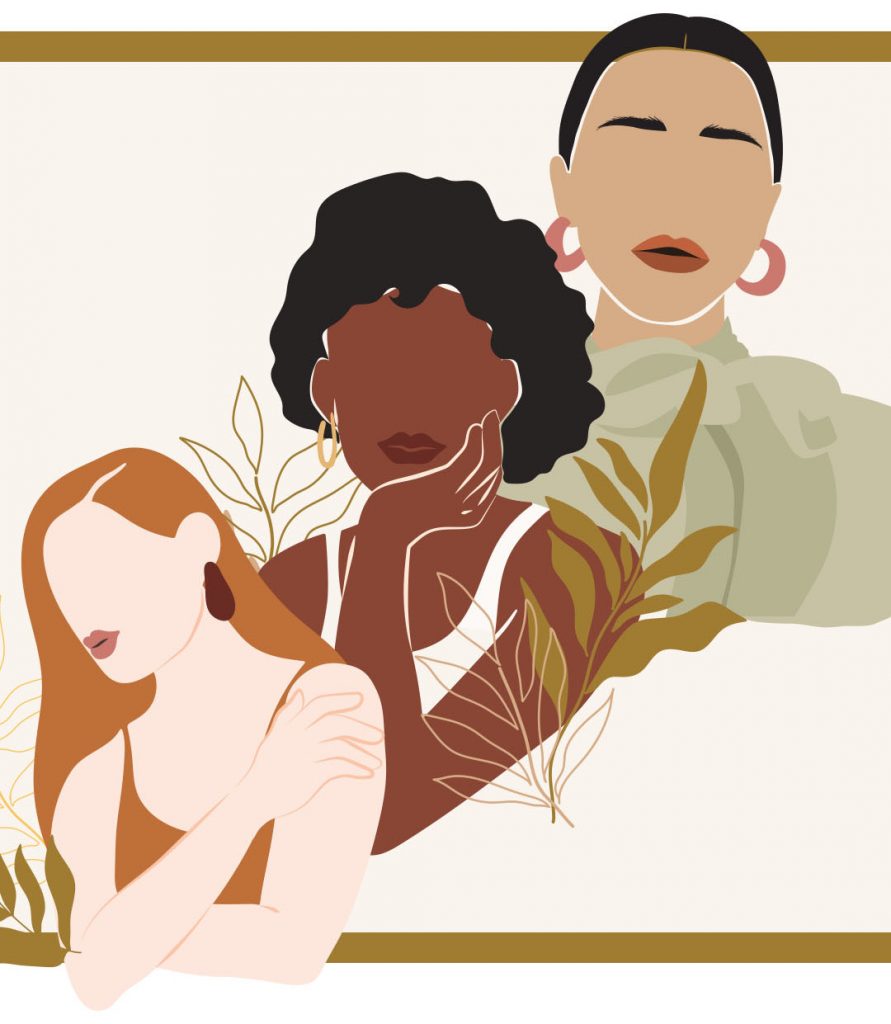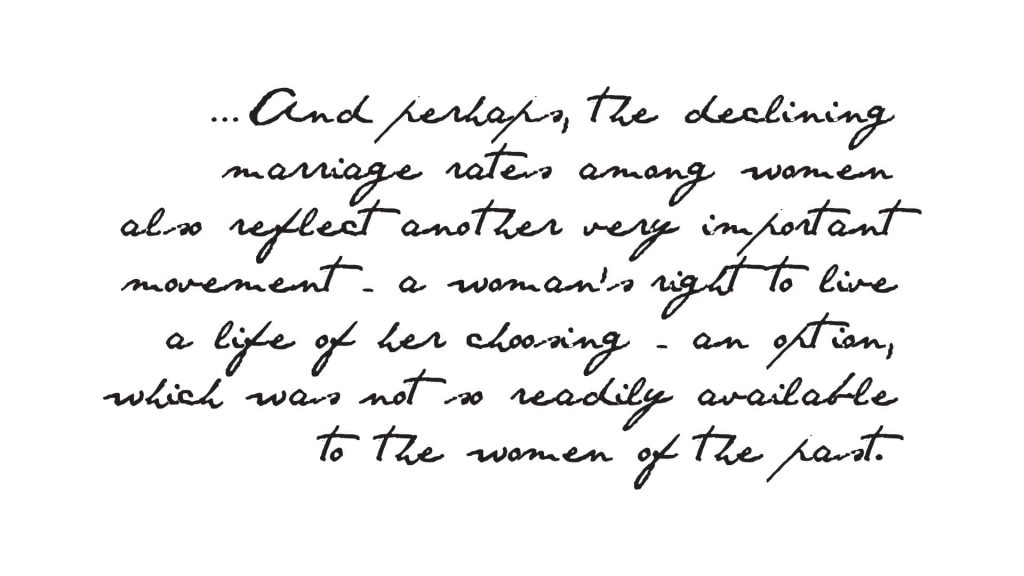All The Single Ladies
When Beyonce’s hit song All The Single Ladies first topped the charts back in 2008, it was an instant hit thanks to its catchy lyrics and dance worthy-beat. But now more than a decade later, the single girls anthem still rings true for a generation of millennial women choosing to marry later — if at all. Once considered a simple pop song, the R&B singer’s chart hit can arguably now be viewed as a historical record highlighting a massive culture shift towards attitudes surrounding marriage. As marriage rates decline and the stereotype of the lonely spinster slowly fades, no longer are women basing their lives around walking down the aisle. This generation of women are finding empowerment and fulfillment by taking relationships at their own pace.
Throughout history, single women within Western countries have not been viewed in a favourable light. During the middle ages, unmarried women were often assumed to be witches or prostitutes — the two terms so interchangeable they were even included in court documents. Religious mania meant these suspected witches were persecuted by communities obsessed with their ‘otherness’ and ‘peculiar’ lifestyles. They did not fit into the traditional roles of what a woman should be and for many, the punishment was death.
Paradoxically, the term ‘spinster’, which came into existence during the mid-1300’s, was originally used to describe what was a respectable class of tradespeople. Despite being a low income and low status job, spinsters were valued members of society who spun thread and yarn. It was one of a handful of roles available to low socio-economic, unwed women. Many of their wages went toward supporting their mother, father and siblings and thus it was thought of as a respectable profession. Traditionally, there was no stigma attached to the term and it was used in a similar fashion to that of a common surname.
At the time, being a spinster provided women with unusual economic and legal freedoms. Spinsterhood, excluded women from the feudal law of couverture which gave men absolute legal power over their wives. These were the only women legally entitled to own and sell possessions, represent themselves in court, sign contracts and earn a wage. However, this all changed during the late 18th century, when popular figures like poets and playwrights began portraying the spinster as someone to be looked down upon, an outcast, essentially a woman who had failed at ‘being a woman’.
There were pieces of writing like Satyr Upon Old Maids, a 1713 pamphlet which described unmarried women as nasty, rank, filthy and rammy alongside other belittling adjectives. And if a woman could not or would not procreate, she was labelled as useless or selfish. Perhaps most telling of the Victorian English’s attitude toward unmarried and childless women at the time came after an 1851 census revealed a “surplus” of these women. Some suggested they be forcefully emigrated, while others called for taxing their finances.
Eventually however, the never-married women of the time, motivated by their impoverishment, paved the way for future female innovators.
They became nurses, academics, journalists and educators, with some even rejecting sexual norms and becoming secret allies to the LGBTQI+ communities.
And while today many unwed women lead successful careers in a vast array of industries, the stigma around being single or unwed remains — albeit fading. Although the term spinster is not likely to arise in conversation, questions about dying eggs or matchmaking with an acquaintances’ distant relative may occasionally still occur. Chantal*, 36, is a successful Kiwi expat and urban designer living in Melbourne, Australia. Although she has a thriving career and arguably lives in one of the country’s most open-minded cities, she is still concerned about revealing her true identity for this story. While happily single, she wishes to avoid any judgement from others in her industry.
“I don’t specifically see myself as a ‘single woman’, although it is often the topic of conversation, I just live my life, and have lived my life as it comes,” says Chantal, who is not opposed to one day marrying, should she find herself in a relationship with a partner where it is feasible. “Relationships come in many forms, I don’t necessarily see marriage as the only answer or option for a life together. But the romantic in me still likes the ideal.” While not actively looking for a partner, Chantal does like the idea of companionship and true love. “The best parts of my life have been with a partner, with family and also with close friends I would say, which would be the same if I was single or not. I think people like you to talk about things like career, independence and freedom when you are single, (that you enjoy or prioritise those things), but I would say I too enjoy career, freedom and independence inside of a relationship also.” Chantal however, doesn’t believe these aspects of life are only to be enjoyed when single. Rather, she views a successful relationship as one which supports all areas of life. And when it comes to children, her views remain the same — although not currently on her radar, she is open to it, when the timing is right.
“I don’t wish to have children purely for myself, I like the idea of creating a family, and the gift or opportunity to have children, in a bond of love, and as an expression of your continued love for one another, and of your extended family also,” she says. “I also think there is a special beauty in a parent’s’ role and ability to transfer and pass knowledge, values, experience and appreciation from themselves to their children.” Chantal, whose parents married young, and are still together, says she finds it more funny and quizzical than challenging when people ask about her relationship status. “I sometimes wonder what people would think if you asked such direct questions about why they are married, how they do or don’t find what they are looking for in their relationships.”
Chantal is not alone in her experience.
An estimated 1 in 4 women in Australia and New Zealand will have never been married by the time they reach their late forties, according to a 2019 report by the United Nation’s Women. Worldwide, 4.3% of women will reach this age without ever marrying, and in the regions listed in the report (Oceania, Latin America, the Caribbean, Europe, North America, Africa and Asia), the number of unmarried women has increased in the two decades between 1990 and 2010. The most notable increase was in fact in Australia and New Zealand, which saw an increase of 9.7%. That’s an increase from just 4.4% in 1990 to 14.1% in 2010.

So what exactly is behind the rise in singledom?
Dr. Lara McKenzie, a Research Fellow at The University of Western Australia’s School of Social Sciences, says there are multiple factors at play. Longer periods of education, career and financial security are just some of the reasons behind declining marriage rates. “People also tend to be in relationships for longer periods before marriage than they were in the past,” she says. “There’s been similar shifts in parenthood, too, with a move to later and lower fertility.” Chantal, shares similar views to McKenzie. “Again, I think it’s less about the relationships and status of [your] relationship and more about how people choose to navigate their lives and their priorities, and dreams. You may face the some of the same challenges whether or not you are in a relationship.”
While many women are opting out of marriage or marrying later, this doesn’t necessarily mean they are forgoing relationships altogether. “What strikes me most is not so much the trends but the complexity of people’s experiences, explains McKenzie. “While the statistics are often taken to suggest that marriage and relationships are less important to people now than in the past, this isn’t necessarily what emerges when you talk to people.” Take for example, couples living in de facto relationships, as McKenzie explains, citing an older couple she had interviewed: “She was in her 50s and he was in his 70s, and they had been together for about 30 years. While I was interviewing her, it emerged that they had never actually been married (something that she realised she had forgotten to tell me). She referred to him as her husband, and he referred to her as his wife, but they had never actually never ‘gotten around’ to marrying, she told me.”
“Looking at the statistics alone, it’s easy to imagine that these are straightforward choices that people are making: to accept, postpone, or reject marriage. But talking to them you see it’s more complex than that.” Interestingly, the idea of romantic love and life-long partnerships is still very much alive, if popular culture is anything to go by. In recent times, reality television shows like Married At First Sight and 90 Day Fiancé have surged in popularity. Both shows are centred around couples tying the knot in a short timeframe. Dr. Lara McKenzie has centred some of her most recent research around the show Married At First Sight. “It’s fascinating, because shows like Married at First Sight often frame themselves as fixing the problem of mass single-hood. If you watch the introductory scenes in their early episodes, they talk explicitly about the move away from marriage, people being single, and the increased difficulties of finding a partner,” she explains. “It’s interesting that you often see these kinds of views among social scientists too. Some argue that relationships are becoming fragile and people are increasingly isolated from one another, and see this as a problem. Others celebrate people’s growing choices and freedoms when it comes to entering into or leaving relationships.” She believes that the push for marriage in shows like these are connected to the increase in cohabiting relationships and people’s fears about loss of commitment and family, adding that “there is a strong emphasis on ‘romantic love’ marriage in places like Europe, Australia, and New Zealand.”
But not all millennials are choosing to wait until later in life to walk down the aisle. Freya is one of the increasingly fewer women who decided to marry early on in life. A 30-year-old Brisbane-based wife, mother and reiki practitioner, Freya tyed the knot at age 23. Also giving birth at a young age, Freya went on to have her first child (a boy) at 25, followed by another child (a girl) at 29. Yet she wasn’t always so taken by the idea of marriage. “For a long time, I wasn’t sure if I would get married – My parents got divorced when I was quite young so I didn’t have a clear representation of what marriage looks like, healthy or otherwise. I guess I just didn’t know what marriage was all about so I didn’t know if it was right for me.” Things however, quickly changed when she met her long-term partner and now husband shortly after graduating high-school. “Our friends and family were all very excited and supportive of our decisions to get married and have children – Fortunately we never really felt pressure from our families to get married and have kids so we were able to make those decisions when it felt right for us without outside influences.” Although her family has always been supportive of her choices, she recognises that not all women are so fortunate. “I think some women do feel societal pressure. I definitely think that that pressure is slowly wearing off – I know so many women who don’t want to have children and are very happily single and that’s very normal now.”
“I don’t know if I felt pressure to marry and have kids. I always wanted to have children – I guess in my relationship we kind of got to a point where we loved each other and wanted to be together for a long time so getting married just seemed like the next thing to do.” Like Chantal, Freya’s happiest moments are spent with loved ones. “I really love being a young mum, I personally have learnt a lot about myself through motherhood, which I think has in turn helped me in my marriage.” However, it hasn’t been without its challenges. Like so many other women, Freya has at times, struggled to balance a full-time career and family life. A challenge, which she says, also highlights why some women are choosing to marry later in life — if at all. After recently leaving a long-term corporate role, Freya is now dedicating her time towards herself, her family and a new-found love of reiki. “I recently returned to my professional job of over eight years after having my daughter – I have been working three days a week but I have found it really difficult to find a healthy balance between home life and work now that I have two children. I actually recently made a decision to leave my role and focus on my family, home and mental health for a while which was really tough but necessary choice for me…marriage is hard with children involved. There isn’t a lot of time for us to be just a couple. By the end of the day, we just want to lie on the couch and watch Netflix in silence,” she says.
With so many factors to consider such as juggling a career, the rising cost of living and the financial burden of a wedding (just to name a few), it’s perhaps no wonder women are choosing to postpone marriage or forgo it all together. And while at face value this might seem like bad news for hopeless romantics and traditionalists, it’s important to remember that this doesn’t necessarily equate to a decline in the value of families, partnerships or love,
as Dr. Lara McKenzie explains.
“One thing that comes across strongly is that couple relationships continue to be a major part of our everyday lives. So although women and men might marry later or less often, they are still often living as couples. We hear about relationships being more fragile and short-term today but, historically speaking, married couples would often spend long periods apart, or had lower life expectancies. So their marriages weren’t necessarily very long-term or time-intensive.” And perhaps, the declining marriage rates among women also reflect another very important movement — a woman’s right to live a life of her choosing — an option, which was not so readily available to the women of the past. Today more women have the freedom to explore relationships and a career at their own pace, the ability to leave an unhealthy relationships and still support themselves as well as advances in technology making childbirth an option for later in life. Today’s women can live a life that is true to her own beliefs — whether that is one which is partnered or partnerless. So here’s to all the single (and married) ladies — the choice is yours.
*Name has been changed to protect identity

Marriage rates across the globe
Around the world, 4.3% of women will reach their late forties without ever marrying. However, these rates, when looked at by region, are strikingly different. For example, in NZ and Australia, one out of every seven women in their late forties will never walk down the aisle. Whereas in places like Central and Southern Asia, the same can only be said for about one in every 100 women.
- 14.1% Australia and New Zealand
- 13.4% Latin America and the Caribbean
- 10.8% Europe and North America
- 6.1% Sub-Saharan Africa
- 4.8% Northern Africa and Western Asia
- 3.7% Oceania (excluding Australia and New Zealand)
- 2.5% Eastern and Southeastern Asia
- 1.1% Central and Southern Asia
Source: UN Women (2010)

